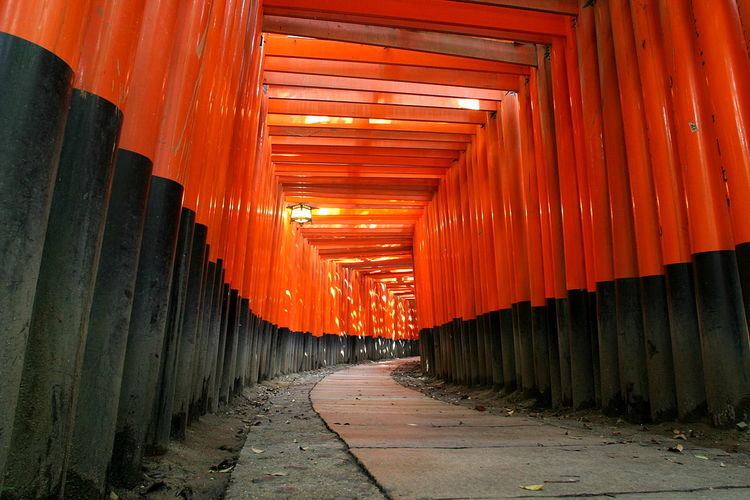Website inari.jp/en/ | Founded 711 Phone +81 75-641-7331 | |
 | ||
Similar Kiyomizu‑dera, Kinkaku‑ji, Nijō Castle, Arashiyama, Ginkaku‑ji | ||
Fushimi Inari Taisha (伏見稲荷大社) is the head shrine of Inari, located in Fushimi-ku, Kyoto, Japan. The shrine sits at the base of a mountain also named Inari which is 233 metres above sea level, and includes trails up the mountain to many smaller shrines which span 4 kilometers and takes approximately 2 hours to walk up.
Contents
- Cycling to fushimi inari taisha shrine the 1000 gates in kyoto japan
- History
- Structures
- Fox
- Access
- Environs
- In popular culture
- References
Since early Japan, Inari was seen as the patron of business, and merchants and manufacturers have traditionally worshipped Inari. Each of the torii at Fushimi Inari Taisha is donated by a Japanese business. First and foremost, though, Inari is the god of rice.
This popular shrine is said to have as many as 32,000 sub-shrines (bunsha (分社)) throughout Japan.
Cycling to fushimi inari taisha shrine the 1000 gates in kyoto japan
History
The shrine became the object of imperial patronage during the early Heian period. In 965, Emperor Murakami decreed that messengers carry written accounts of important events to the guardian kami of Japan. These heihaku were initially presented to 16 shrines, including the Inari Shrine.
From 1871 through 1946, Fushimi Inari-taisha was officially designated one of the Kanpei-taisha (官幣大社), meaning that it stood in the first rank of government supported shrines.
Structures
The earliest structures were built in 711 on the Inariyama hill in southwestern Kyoto, but the shrine was re-located in 816 on the request of the monk Kūkai. The main shrine structure was built in 1499. At the bottom of the hill are the main gate (楼門, rōmon, "tower gate") and the main shrine (御本殿, go-honden). Behind them, in the middle of the mountain, the inner shrine (奥宮, okumiya) is reachable by a path lined with thousands of torii. To the top of the mountain are tens of thousands of mounds (塚, tsuka) for private worship.
Fox
Foxes (kitsune), regarded as the messengers, are often found in Inari shrines. One attribute is a key (for the rice granary) in their mouths.
Unlike most Shinto shrines, Fushimi Inari Taisha, in keeping with typical Inari shrines, has an open view of the main idol object (a mirror).
A drawing in Kiyoshi Nozaki's Kitsune: Japan's Fox of Mystery, Romance and Humor in 1786 depicting the shrine says that its two-story entry gate was built by Toyotomi Hideyoshi.
The shrine draws several million worshipers over the Japanese New Year, 2.69 million for 3 days in 2006 reported by the police, the most in western Japan.
Access
The shrine is just outside the JR Nara Line Inari Station, a 5-minute ride from Kyoto Station. It is a short walk from Keihan Electric Railway Main Line Fushimi-Inari station.
Honden is lighted up, and the approach to the Fushimi Inari-taisha is lit up all night, so it is easy to visit at night.
There is no closing time without entrance fee.
Environs
In the approach to the shrine are a number of sweet shops selling tsujiura senbei (辻占煎餅), a form of fortune cookies dating at least to the 19th century, and which are believed by some to be the origin of the Chinese-American fortune cookie.
